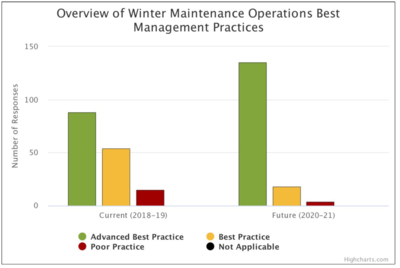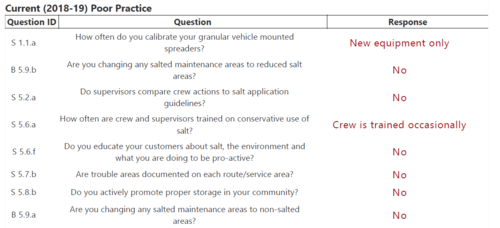
Guidance for meeting chloride TMDL MS4 permit requirements Revision as of 16:51, 10 May 2020 by Mtrojan (talk | contribs) (→Total Maximum Daily Loads (TMDLs))
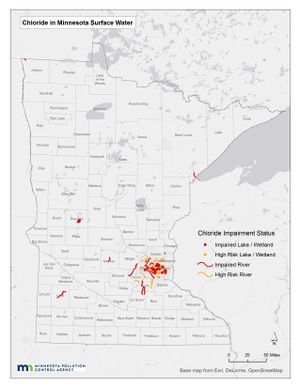
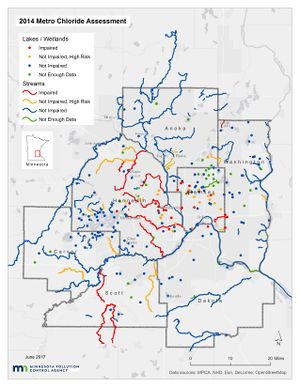
This page provides guidance for MS4 (Municipal Separate Storm Sewer System) permittees who have permit requirements for chloride total maximum daily load wasteload allocations.
Contents
Total Maximum Daily Loads (TMDLs)
There are currently 40 lakes and streams in the Twin Cities Metro Area that are impaired by chloride. There are an additional 10 lakes and streams that are impaired by chloride in greater Minnesota. See the MPCA’s chloride webpage for more information on the sources of chloride, environmental impacts, and opportunities for your community to reduce salt.
The EPA has approved 40 total maximum daily loads (TMDLs) that include MS4 (Municipal Separate Storm Sewer System) wasteload allocation (WLAs) for chloride. Click here to link to MPCA's impaired waters website. A map illustrating U.S. EPA-approved listings for chloride is shown on the right. The TMDLs were developed as part of the Twin Cities Area Metro Chloride TMDL, Ninemile Creek TMDL, and the Shingle Creek TMDL. See the statewide chloride resources page for more information.
The MS4 permit contains the following requirements for permittees that have an applicable wasteload allocation (WLA) for chloride.
- Permit item 22.5: If the permittee has an applicable WLA for chloride, the permittee must document the amount of deicer applied each winter maintenance season to all permittee owned/operated surfaces
- Permit item 22.6: If the permittee has an applicable WLA for chloride, each calendar year the permittee must conduct an assessment of the permittee's winter maintenance operations to reduce the amount of deicing salt applied to permittee owned/operated surfaces and determine current and future opportunities to improve BMPs. The permittee may use the Agency’s Smart Salting Assessment Tool or other available resources and methods to complete this assessment.
- The permittee must document the assessment. The assessment may include, but is not limited to:
a. operational changes such as pre-wetting, pre-treating the salt stockpile, increasing plowing prior to deicing, monitoring of
road surface temperature, etc.;
b. implementation of new or modified equipment providing pre-wetting, or other capability for minimizing salt use;
c. regular calibration of equipment;
d. optimizing mechanical removal to reduce use of deicers; or
e. designation of no salt and/or low salt zones.
- Each calendar year, conduct an assessment of the permittee’s winter maintenance operations to reduce the amount of deicing salt applied to permittee owned/operated surfaces and determine current and future opportunities to improve best management practices (BMPs). The permittee may use the Agency’s Smart Salting Assessment Tool or other available resources and methods to complete this assessment. The permittee must document the assessment. The assessment may include, but is not limited to:
- operational changes such as pre-wetting, pre-treating the salt stockpile, increasing plowing prior to deicing, monitoring of road surface temperature, etc.;
- implementation of new or modified equipment providing pre-wetting, or other capability for minimizing salt use;
- regular calibration of equipment;
- optimizing mechanical removal to reduce use of deicers; and/or
- designation of no salt and/or low salt zones [Minn. R. 7090] (Permit item 22.6).
Document the amount of deicer applied
Permit item 22.5 - Document the amount of deicer applied each winter maintenance season to all permittee owned/operated surfaces.
Permittees are required to track the amount of deicer applied. For each application event, permittees should also consider tracking the following.
- material used (e.g. sodium chloride, calcium chloride, etc.)
- location where material was applied
- date
- air temperature
- pavement temperature
- relative humidity (RH)
- dew point
- cloud cover
- operator
- event start
- event end
- event type (e.g. snow, rain, both)
- total precipitation, and
- application rate.
The Minnesota Snow and Ice Control Field Handbook for Snowplow Operators includes examples of salt tracking forms that could be used (see Appendix). The Winter Parking Lot and Sidewalk Manual also includes tracking forms for anti-icing and de-icing (see below).
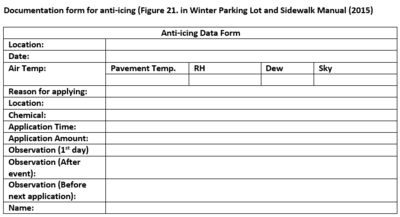
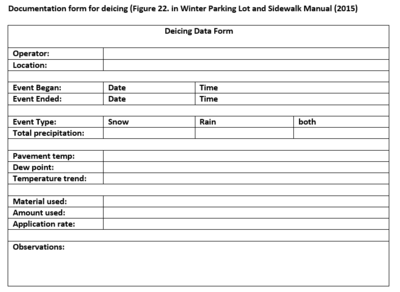
Annually conduct an assessment of the permittee’s winter maintenance operations
Permit item 22.6 - Annually conduct an assessment of the permittee’s winter maintenance operations to reduce the amount of deicing salt applied to permittee owned/operated surfaces and determine current and future opportunities to improve BMPs.
Permitted MS4s with an applicable WLA for chloride are required to assess winter maintenance operations annually and identify current and future opportunities to improve practices to reduce the amount of de-icer used. The permittee may use the Smart Salting Assessment Tool (SSAt) or other available resources and methods to complete this assessment.
Using the Smart Salting Assessment Tool (SSAt) for MS4 permit compliance
The SSAt has been developed as a resource of all known current salt saving BMPs. The SSAt is a free, web‐based tool that can be used to assist public and private winter maintenance organizations in determining where opportunities exist to improve practices, make reductions in salt use and track progress. The SSAt creates a number of reports based on the data you provide describing your past, current, and future operations. Below is a hypothetical example of an assessment that was completed in with the SSAt and the various reports generated by the tool. The hypothetical example includes an assessment of current and future operations for low and high speed roads.

.
BMP high-level overview report: overview of winter maintenance operations best management practices
The chart below is based on a completed Winter Maintenance Best Management Practices (BMP) assessment. The assessment consists of a series of multiple choice questions that cover all aspects of winter maintenance operations, such as policy, storage, application, and education. Each answer for a question is classified as an Advanced Best Practice (green), Average Best Practice (yellow), or Below Average Practice (red).
BMP summary report
The BMP Summary Report indicates how many different types of practices (advanced, best, poor, not applicable) practices you are currently implementing and how many you plan to implement in the future.
BMP list for current (2018-2019)
This report provides detailed information on current practices. This report could be used to help you prioritize what poor practices you want to work on improving in the coming years. Below is an excerpt from the report. The actual report includes responses to questions for all BMPs that are included in the tool.
Related pages
To link to other pages providing information and guidance on TMDLS, click here

